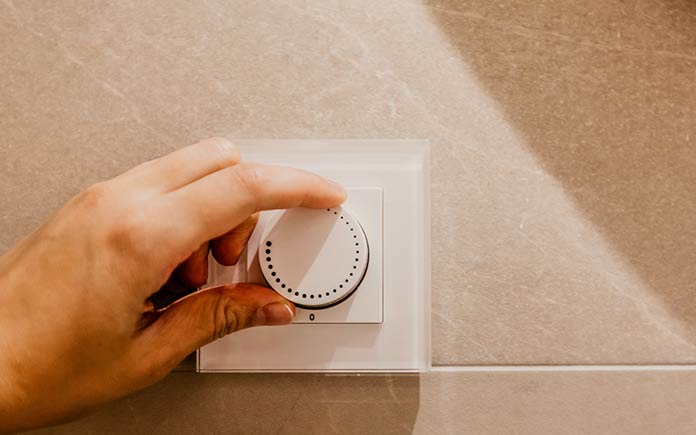
On this Week’s Podcast: Dog’s Killing Grass
We help a homeowner with some dogs whose urine is killing the grass in her backyard.
Cathy says her two dogs are doing their “business” right off the steps of her deck. Her ground slants toward the deck, adding another issue to the dog mess.
Dogs are one of the biggest culprits of causing a lawn’s brown spots. Urine usually causes your lawn to turn yellow in spots, sometimes with a bright green ring around the edges where diluted nitrogen in the urine acts as a fertilizer.
So, what can Cathy do about this? We suggest purchasing some pavers! Installing pavers at the bottom of the deck will create an unpleasant spot for the dogs, and create a new way to flow the mess away from the deck.
Laying a paver patio can make a great DIY project. Here’s how to do it:
• Decide on the area the patio will cover, and pull strings to mark the borders. Allow for about 1 inch of slope away from the house for every 8 feet of the patio. That way, water will drain.
• Dig out the soil 5 inches deep, plus the thickness of the pavers from the desired finished height of the patio, to allow for 4 inches of the base material, 1 inch of sand and the pavers. Use a plate compactor (available for rent at home centers) to compact the soil to prevent settling.
• Add 4 inches of the compactable base material, such as crushed limestone, to the excavated patio area. Pack down the base material using a plate compactor. Misting with water while compacting the base material reduces dust and aids in compaction.
• Lay straight 1-inch-thick steel pipes on top of the base material on each side of the patio to act as guides for leveling the sand. Pour 1 inch of sand on top of the base material and use a straight 2-by-4 on edge as a screed on top of the pipes to level the sand to a consistent thickness. Remove the pipes and fill in the void left behind.
• Start at one corner of the patio and lay the pavers on top of the sand, being careful not to step on the sand. Use a concrete saw or wet saw (available for rent) to cut any partial pavers to size. (Wear an approved dust mask or respirator if dry-cutting pavers).
• Pour concrete halfway up the thickness of the pavers around the outer edge of the patio to secure the paver border in place. After the concrete has set, cover it with dirt or grass to hide the concrete.
• Sweep paver sand into the joints between the pavers to fill them.
If dog urine is killing your grass, try these solutions:
• Water your lawn: The best way to reduce damage to your lawn is to dilute the urine by saturating the spot with water. This approach also works if you accidentally spill fertilizer on your yard.
• Water your dog: Make sure your dog is well hydrated to dilute the urine’s strength. Adding some canned dog food, or moistening dry food with a little water, is another way to add water to their diet. Many dietary additives make your dog thirstier (usually by adding salt), leading to more water consumption.
• Train your dog: Train your dog to urinate in a designated space away from the main lawn. While this may sound like a daunting task, dogs really can be trained to go in specific places on command. Make sure the area has mulch or pea gravel that is easy to replace and keep clean.
• Plant resistant grasses: Fescues and ryegrass are more resistant to urine burns than grasses like Kentucky bluegrass and Bermuda.
Remember:
• A healthy, maintained lawn can withstand the occasional overdose of nitrogen better than a stressed lawn.
• Your local pet store likely has a variety of products claiming to bind and neutralize urine. Results on these products are not proven, so consult your vet to make sure they are safe before using them. Generally, it’s better to use solutions that work with biology and nature, rather than trying to alter it.
Also in this week’s podcast:
• A strange smell in your home can be alarming. We discuss 7 household smells that could signal danger.
• Learn about a product that will give your furniture a distressed, antique look.
• Do you want to remove wallpaper? Try this formula!
• A homeowner is having a hard time finding the right paint to repair and refinish the cabinets — here are our suggestions
• Follow Joe’s Simple Solution to create a homemade disinfectant.
Question of the Week
Tom from Virginia writes, “I want to install carpet. I have laminate flooring now, and I was told the laminate had to come up before the carpet was laid. What are your thoughts on this project?”
DIY Project of the week
How to Install a Dimmer Switch

Replacing a standard wall switch with a dimmer switch is a great way to improve your home’s atmosphere.
More Inspiration
How to Declutter and Organize Your Home in 2020
Renovate Your Home the Eco-Friendly Way | Ep. 59
Leak or Condensation? How to Identify Mysterious Moisture| Ep. 58



